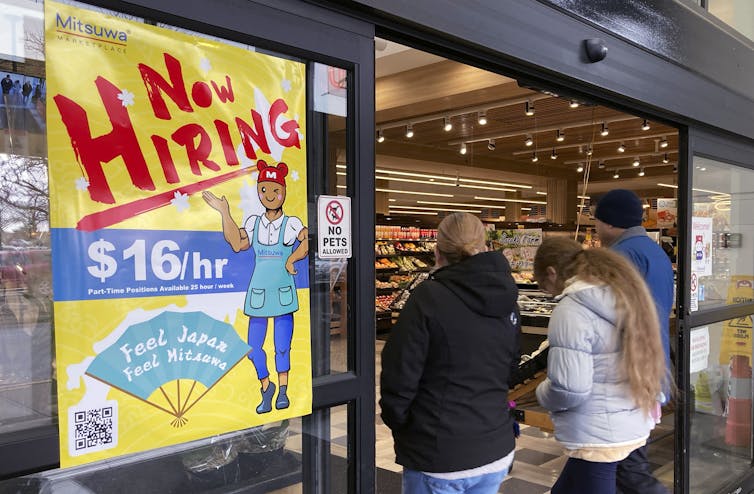Why employment remains red hot even as the Federal Reserve tries to put job market on ice

By Edouard Wemy, Clark University
The hot U.S. labor market is showing few signs of cooling down, with the latest jobs report showing continued strong gains, particularly in service industries such as retail and hospitality. The robust employment landscape may put pressure on the Federal Reserve to raise rates more than expected later this month in a bid to further tame inflation.
The U.S. economy added 311,000 jobs in February, the Bureau of Labor Statistics reported on March 10, 2023, higher than economists were forecasting. The unemployment rate ticked up slightly to 3.6%, still near the lowest level in over 50 years.
To better understand what all this means and why the job market remains strong despite the most aggressive pace of interest rate hikes since the 1980s, we turned to Edouard Wemy, an economist at Clark University.
What stood out for you most in the jobs report?
It’s kind of strange how the labor market remains quite strong, with notable gains in labor-intensive service sectors like hospitality and leisure, health care and retail. That’s also where wage growth in February was strongest.
For workers, the report is good news, since it suggests if you’re looking for work you’ve got a strong chance of finding a job. The Job Openings and Labor Turnover Survey shows that there are almost two vacancies for every unemployed worker, which is pretty high compared with an average of under 0.6 vacancies per jobless person before the pandemic.
But it’s very puzzling. Why is the job growth so strong at a time when the Fed has been aggressively raising borrowing costs to tame the highest inflation since the 1980s? Typically, a sudden increase in interest rates – and the Fed has raised rates 4.5 percentage points over the past year – would chill the labor market and send unemployment much higher.
I believe, as is often the case in economics, it’s a question of supply and demand. The Fed has been focused on the latter. Raising the borrowing costs consumers and businesses have to pay should reduce consumer demand for goods and services, which in turn lowers demand for workers.
But the Fed can’t do much about the supply side of the equation – which refers to the number of available workers in the labor market. That’s measured by the participation rate, which plunged at the beginning of the pandemic and still hasn’t fully recovered to pre-COVID-19 levels. This is especially true for men, who are participating in the labor market at a rate of 68%, or 1.1 percentage point below February 2020 levels – the equivalent of about 1.5 million men gone from the workforce.
In other words, if the reason the job market is so tight right now is the relatively low participation rate, then that explains why the Fed’s interest rate hikes are not having much of an effect.
Why is the participation rate still low?
Economists, me included, are trying to work that out and have some theories.
The pandemic caused significant disruptions to the labor market – first, lockdowns caused unemployment to soar, then trillions of dollars in government aid meant to support the economy made it easier to get by without a job – and this has resulted in structural changes that persist today.
Recent research suggests part of the explanation for the lower participation rate is that more younger workers may be joining the gig economy, which isn’t fully reflected in the government’s job and participation numbers.
What does this mean for Fed’s rate-hike campaign?
A few weeks ago markets were expecting the Fed to lift interest rates by another quarter-point when it meets on March 21-22. That changed after Fed Chair Jerome Powell told Congress on March 7 that the rate-hiking campaign still “has a long way to go.”
After the latest jobs report showed the strength of the labor market, I agree that a half-point increase is likely. But I’m hoping the Fed isn’t going to push up rates much more.
If the reason for the hot jobs market is primarily a supply or structural issue, then higher rates aren’t going to have the effect the Fed seeks – and would only increase the odds of recession. So I’m hoping the Fed’s economists recognize this and adjust their strategy.
What are the odds of a recession?
I still don’t think a recession is likely, mainly because recent economic data, such as solid consumer spending along with the latest jobs report, have been so strong. But also I do believe the Fed will change its tune, accept inflation may be a bit higher than it hopes and slow the pace of rate hikes.
But if the Fed stays focused on driving inflation to near its target of 2% – from an annual pace of 6.4% currently – that would greatly increase the odds of a recession this year or the next.![]()
Edouard Wemy, Assistant Professor of Economics, Clark University
This article is republished from The Conversation under a Creative Commons license. Read the original article.
Image by Gerd Altmann from Pixabay



